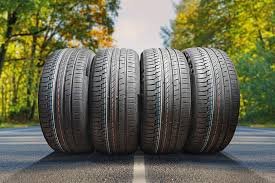
Choosing the right tire size plays a critical role in ensuring your vehicle performs at its best, whether for off-road adventures, city driving, or highway cruising. Tires like 265/40 R22 and 285/65 R18 serve different driving needs, offering unique benefits in terms of traction, comfort, and fuel efficiency. In this blog, we’ll explore the specifications, differences, and ideal uses for each tire size, so you can make the right choice for your driving style and vehicle type.
Decoding the Tire Sizes: What Do 265/40 R22 and 285/65 R18 Mean?
Each component of a tire specification, like 265/40 R22 or 285/65 R18, gives insights into the tire’s dimensions and performance characteristics. Here’s a breakdown of what each number and letter represents:
- 265/40 R22:
- 265: This is the width of the tire in millimeters, measuring from sidewall to sidewall. At 265 mm, it’s a relatively wide tire, offering a larger road contact area for enhanced stability.
- 40: The aspect ratio, which represents the height of the sidewall as a percentage of the width. Here, 40% gives the tire a shorter sidewall, which improves handling, especially at higher speeds.
- R22: The “R” stands for radial construction, the most common tire type for modern vehicles. The 22 refers to the diameter of the wheel the tire is meant to fit, measured in inches. A 22-inch diameter is typically found on larger SUVs and high-performance vehicles.
- 285/65 R18:
- 285: This tire width is 285 mm, making it even wider than the 265, which can provide additional traction and stability, especially in rugged terrains.
- 65: The aspect ratio is 65%, meaning this tire has a taller sidewall compared to the 265/40 R22. A higher aspect ratio enhances ride comfort, particularly useful in off-road or uneven road conditions.
- R18: This radial tire fits an 18-inch wheel, a common size for off-road or heavy-duty trucks and SUVs where durability and versatility are key.
Key Differences Between 265/40 R22 and 285/65 R18 Tires
While both tires are radially constructed, they differ significantly in terms of width, aspect ratio, and ideal applications. Here’s a closer look at how each tire performs under different conditions:
- Performance:
- 265/40 R22 tires have a low aspect ratio and a large diameter, making them ideal for performance-oriented driving. This size is often preferred on large, high-performance SUVs and sports-oriented trucks due to the lower sidewall, which provides improved stability and handling at high speeds.
- The 285/65 R18 tire’s wider width and higher sidewall make it an excellent choice for off-road vehicles. This tire is built for ruggedness, capable of handling challenging terrains with ease, and offers superior shock absorption for a smoother ride on uneven surfaces.
- Comfort and Ride Quality:
- With its shorter sidewall, the 265/40 R22 tire provides a firmer ride, which is great for handling but may feel stiffer on rough or uneven roads. This makes it well-suited for smooth city streets and highways but may transfer more vibrations on rugged terrains.
- The 285/65 R18, with its taller sidewall, excels in absorbing bumps and shocks, providing a smoother and more comfortable ride over rocky or off-road conditions. This tire is a popular choice for truck and SUV drivers who prioritize comfort over sporty handling.
- Traction and Stability:
- Both tires offer excellent traction, but they’re tailored to different road conditions. The 265/40 R22 is designed to maximize road grip on pavement and offers superior stability during high-speed maneuvers. Its width and low profile provide precise handling and control, making it ideal for urban and highway driving.
- The 285/65 R18 is built for versatile traction, particularly off-road. Its wider width and higher sidewall height enable it to handle loose dirt, gravel, and mud, providing enhanced stability on uneven surfaces and rough trails. This tire’s build is perfect for adventurous drivers who need extra control off the beaten path.
- Fuel Efficiency:
- Generally, a wider tire with a larger contact area increases rolling resistance, potentially affecting fuel efficiency. The 265/40 R22 may offer better fuel efficiency on smooth, paved surfaces due to its lower rolling resistance, thanks to its lower sidewall profile.
- The 285/65 R18, with its larger sidewall and wider profile, is designed to handle challenging terrain but may slightly reduce fuel efficiency, especially on highways. For off-road enthusiasts, this minor trade-off is often worthwhile for the enhanced durability and performance.
Ideal Uses for 265/40 R22 and 285/65 R18
Both tire sizes cater to different vehicle types and driving styles. Here’s a guide to help you decide which tire is the best fit for your needs:
- 265/40 R22:
- Best for: High-performance SUVs and trucks used mainly for city driving, highways, or sporty driving on paved roads.
- Highlights: Excellent for drivers seeking precision handling, stability at higher speeds, and a stylish, low-profile look.
- Considerations: This tire size is less ideal for off-road conditions, as it may not provide the level of shock absorption needed for rough terrain.
- 285/65 R18:
- Best for: Trucks, heavy-duty SUVs, and off-road vehicles designed for rugged trails, outdoor adventures, and versatile driving needs.
- Highlights: Superior traction, shock absorption, and comfort on uneven or rocky roads, making it ideal for off-road enthusiasts or drivers in areas with challenging terrain.
- Considerations: This tire size may slightly reduce fuel efficiency on paved roads, and the taller sidewall could feel less stable at high speeds on highways.
Final Thoughts
Both 265/40 R22 and 285/65 R18 tires offer unique advantages tailored to different driving conditions and vehicle types. The 265/40 R22 provides a sporty, responsive feel that’s ideal for high-speed city and highway driving, while the 285/65 R18 offers durability and comfort for off-road adventures and rough terrain.
Before making a decision, consider your vehicle’s primary use and the types of roads you frequently encounter. Consulting with a tire expert can help ensure that you choose the size that best matches your driving needs and enhances your vehicle’s performance and safety.



